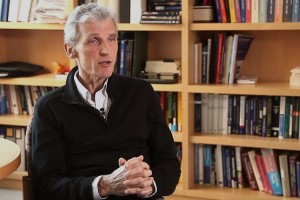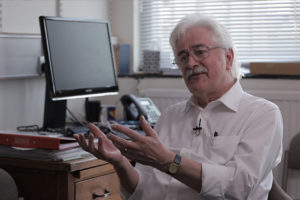Quantum Simulation
Nobel Prize-winning physicist Wolfgang Ketterle on simulating superfluidity, 'atomic Legos', and a special-pur...
Why do most of the young researchers go into mainstream science? What is the secret of success of the Bell labs? Why should scientists deviate from standard models from time to time? These and other questions are answered by Frank B. Baird, Jr. Professor of Science, Chair of Astronomy Department at Harvard University, Director of Institute for Theory and Computation Avi Loeb.
So a fundamental question is how to nurture scientific discoveries despite their unpredictable nature.
We cannot tell in advance which idea would lead to a breakthrough, but we can in principle develop a culture where it’s considered appropriate to question authority, to actually explore ideas that may turn out to be wrong, that are somewhat risky.
And if we look at the business world, it turns out that, for example, Bell Labs for many decades developed a culture like that: they had a group of physicists that they put in the same corridor. These were very creative individuals that were allowed to think about problems that do not have a practical application necessarily. Even though they were doing so within an organization whose purpose is to make money, but these people were given freedom of thought. At the same time they were strongly connected to experimentalists. So that’s another very important ingredient: just pure thought could lead you in directions that have no relevance to reality. And so having interaction or a dialogue with people that collect data or are able to test ideas through experiments is very important – it develops a healthy dialogue between theories that come up with ideas and testing these ideas and finding out which one works and which one is a good description of reality, that’s an extremely important element.
And so Bell Labs developed that culture and harvested a lot of fruits over the decades that it did so: the laser was invented there, the CCD, the discovery of the cosmic microwave background came out of Bell Labs. So, in many of these cases the discoveries could not have been predicted. So you can ask how did they nurture these discoveries in that environment, and the answer is they allowed a group of talented creative people to venture, to take risks, to come up with ideas that will not necessarily succeed – and most of the time ideas do not work out. As long as that is allowed and that is encouraged, every now and then you stumble across a discovery that changes the way people think, and overall when you integrate over a long period of time, you find out that, in fact, it’s a good business practice, you can actually benefit and make a profit from such a culture. So even though on a daily basis you often see initiatives that do not turn out to be productive, every now and then you get one that makes a breakthrough, that pays for all the other failed attempts.
And surprisingly funding agencies in science did not fully realize this practice, even though the business world did so, and so one aspect of my advocacy is to argue that federal funding agencies in science should allocate a small fraction of their funding, say ten to twenty percent, to risky projects or projects that take a risk, it’s not clear whether discovery would come out of it. Most of the time they would fail, but every now and then we might harvest the fruits of that discovery. In addition, in parallel to that I would like to encourage young people to take risks. There is clearly a pressure on young people to get a job, and so that’s why they often advocate mainstream ideas that resonate with the leaders of the field that provide these jobs, but at the same time I think to differentiate yourself from a large group of people.
There is a very heavy competition nowadays among young people, and in order to make yourself special and different you do have to invest a small fraction of your time also in risky ideas. You can’t just do what everyone else is doing, because then you are indistinguishable from everyone else.
So, aside from that I think it’s very important to recognize that having a diversity of ideas is very positive: often people advocate diversity in terms of ethnic origin or gender. Having more women in science is very important, and having minorities participate in scientific research is extremely important as well, but there needs to be also encouragement of diversity of ideas, so that not everyone is subscribed to the same dogma, and people explore multiple ideas at any given time and use experiments and data to rule out those that are not relevant to reality, because every now and then the community as a whole is going in the wrong direction, and the only way to correct that would be for people to explore other ideas. So at any given time there should be always multiple ideas, diversity of ideas, and using experiments to rule out some of the ideas allows us to make progress.
The dark matter accounts for most of the matter in the universe, more than eighty percent of the matter in the universe is dark, and we don’t know if it’s a new type of particle, maybe it’s something else, perhaps, it’s modified gravity. Perhaps, gravity the way we describe it is not accurate, and that’s why we think there is dark matter, but actually there is no dark matter. And until we find out the answer to this, we should be somewhat sceptical of the standard cosmological model. The standard cosmological model also has another component which is actually dominant in the present day universe, and that’s the vacuum, mass density, the so-called cosmological constant. It accounts for 70 percent of the mass budget of the universe. So we have the dark matter making eighty percent of the matter in the universe, and then we have that dark energy, or the cosmological constant, the vacuum energy density making up seventy percent of the mass budget of the universe. And so basically the only constituent that we know about and we fully understand is ordinary matter which makes up just about 5% of the matter of the universe, and the rest is dark. And so I’m not saying that the description we have of the dark matter and dark energy is wrong, but I’m saying that we should remain sceptical until we figure out what is the dark matter and what is this dark energy that causes the accelerated expansion of the universe. So, at this point in time even though we know a lot, we’re still quite ignorant as to the constituents of the universe, and it’s really surprising that we are getting paid to do cosmology these days, because we still don’t understand what most of the universe is made of.

Nobel Prize-winning physicist Wolfgang Ketterle on simulating superfluidity, 'atomic Legos', and a special-pur...

Physicist Marzena Szymanska on the properties of photons, fluids of light and whether it’s possible to make a ...

Physicist David Southwood on how the magnetic field of Earth causes natural losses of spacecraft, the aurorae ...